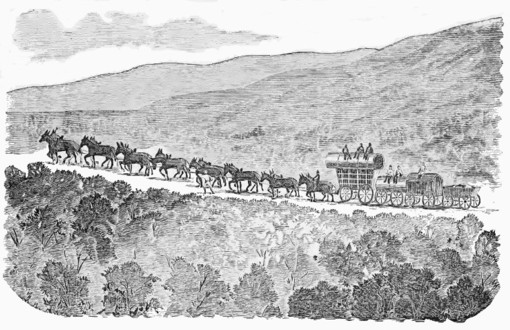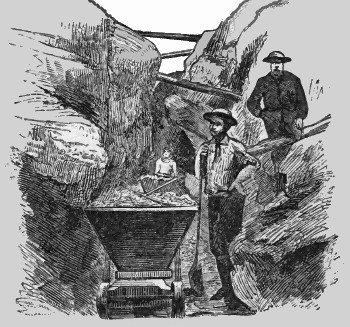Very few gold-bearing lodes contain nothing but free gold; on the contrary, they carry the bulk of their values in the form of sulfides, having more or less gold incorporated, and even when the gold is native and free-milling at the surface, it is generally changed into sulfides as depth is gained. So the miner has to consider methods of recovery more complicated and expensive than simple amalgamation with mercury, for upon gold included in pyrites mercury has no effect. Titanic iron, hematite, and tungstate of iron often hold gold, or soft clay ores carry it in their midst, and such combinations tax all the skill of the mining engineer merely to save a respectable percentage of the assay value. Veins, lodes, or ledges, may be found in stratified or unstratified rocks, and in the former they generally cut the beds at an angle. Veins are bounded by walls. The rock in which a vein is found is a country rock. Smooth walls are called "slickensides." The upper wall of an inclined vein is the hanging wall ; the other the foot wall. A layer of clay between the veins and wall is a selvage. A mass of rock enclosed in the vein is a horse. The vein stone, or gangue, is all that part of a vein that is not mineral. The throw of a fault in a vein is measured by the amount of vertical displacement. When the miner comes to a fault, he should follow the greater angle in his attempt to recover the lode.
Sometimes chlorination and sometimes cyanization are the measures tried, but supposing the preliminary treatment to have been by stamps in the battery, concentrating is one of the main reliances of the mill man. The blanket table is undoubtedly the oldest type of concentrating machine, but it is very inferior to modern inventions. Shaking tables often do good work. In this system a sharp and frequently repeated blow is given the table, in such fashion as to make the heavy material separate from the light. "Shaking" and "rocking" tables are favored in some mills, and they give better results on fine gold than any of the previously mentioned devices. But the best machine so far invented is the Frue Vanner an endless rubber band drawn over an inclined table, having both revolving and side motions. The lighter particles are carried off by water, and the heavier collected in a trough.
Tables must be water-tight, with half an inch to one inch drop to the foot, according to the fineness of the gold. Below them tables, having the same inclination and covered with blanketing, are used to retain specks of gold that have passed over the plates without amalgamating After the concentrated materials, always spoken of as the concentrates, have passed over the tables, they are often roasted to get rid of the sulfur, arsenic, etc., and afterwards treated with quicksilver in the pan, or tin, with chlorine or cyanide. These processes belong, however, to the domain of the professional chemist and metallurgist, and require the knowledge and experience of an expert to stand a chance of success.
The coarseness of the mortar screens is subject to infinite variety, according to individual preference. The number of holes to the square inch ranges between 60 and 800 in Australia, and between 900 and 10,000 in the United States. The holes, when round, agree in numbers with those of sewing-machine needles, from o to 10. When slots are preferred to holes, they are generally 1-inch in length and No. 6 diameter. Russia sheet iron, or sheet steel 1 -32-inch thick is the material of which they are made. It should weigh one pound to the square foot, be very soft and tough, have a clean, smooth surface, and show no rust or flaws. In Australia 1-16 sheet copper is preferred. The holes in any case must be punched in the sheet so that the rough edges are turned, and thus any pulp that finds its way into one of the holes is certain to get out again and not clog. A battery may require 13 sets of screens a year; each screen having a surface of about 11 square feet. Russia iron screens endure 15 to 40 days. As the work a stamp can do depends entirely upon how much pulp can escape through the screen in any given time, the latter is evidently a very "important detail of a battery.
Prospecting stamp batteries differ from ordinary batteries, chiefly in being of light build and weight. Amalgam coming from battery stamps is often mixed with all sorts of rubbish. After being gathered, it is dried with a sponge, foreign matter picked off the surface and clean quicksilver added. Soft unglazed paper thrust into the mercury removes the last vestiges of water, and then a card is drawn vertically or a piece of blanket horizontally across the mercury to clean it of iron. After squeezing, the amalgam is retorted. All the amalgam is placed in one large kettle and, if possible, the latter is put on a strong table having an inclined surface with a groove and hole at the lower end to catch any stray globules of quicksilver. Sodium amalgam, one ounce to each 75 pounds of mercury, is put in the amalgam kettle and the whole stirred. This sodium amalgam is not absolutely necessary, but is desirable. After some minutes, water is poured on the mercury and the whole stirred. All dirt rises to the surface and is removed with a sponge. The cleaning is continued until the mercury seems absolutely free from any impurity, when it is dried with a sponge. It is next turned into pointed bags of stout canvas and force applied until most of the quicksilver has squeezed through. The amalgam remains behind. The quicksilver still contains some gold, but it had better remain if the mercury is to be used again, as gold attracts gold; it can always be recovered by retorting.
Sodium amalgam is best made by the miner himself, enough for one clean-up at a time. Metallic sodium and quicksilver are the necessary ingredients; the former being kept in a wide-mouthed bottle covered with coal oil. A frying-pan makes a useful mixer. It must be dry and clean. Five pounds of clean mercury is poured into the pan, and dried with a sponge, and heated beyond the boiling-point of water, but not much above, or there will be a sensible loss of mercury. A piece of sodium is wiped dry, cut into 2-inch squares and placed with a long pair of tongs in the center of the warm quicksilver, which, by the way, is now off the fire and in the open air, the operator meanwhile keeping religiously to windward of it, unless he courts salivation and all its attendant ills. As soon as the sodium touches the mercury a flash and mild explosion will follow, but after a few cubes have been introduced into the frying-pan, always in the center, this will cease. As soon as a solid mass of amalgam forms in the middle of the pan, the contents must be stirred slowly, and a little more sodium added. The whole mass now crystallizes out, and if put into closely-stopped bottles it will keep without further protection for a little time. Once opened, each bottle must be used. Observe all these directions faithfully, then there will be little danger of inhaling mercurial fumes nor of being blown to atoms. In retorting amalgam never fill the flask too full, and apply the heat gradually, and always from the top of the flask downward. Mercury that has been "sickened," that is to say, has lost its brightness and power of amalgamating, may often be cured by washing with an extremely weak solution of sulfuric acid and adding a little zinc.
Continue on to:
Examples of Old Time Milling Processes For Various Ores
Return To:
Hard Rock Quartz Mining and Milling


